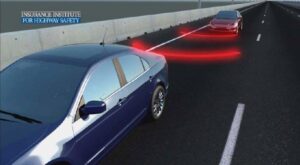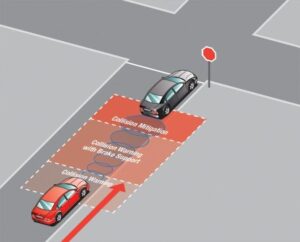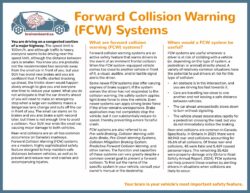FCW Systems
You are driving on a congested section of a major highway. The speed limit is 100km/h, and although traffic is heavy, everyone seems to be driving near the speed limit, although the distance between cars is smaller. You know you are probably not the recommended two seconds away from the small car in front of you, but your SUV has brand new brakes and you are confident that if traffic started bracking up ahead, the trickle-down would happen slowly enough to give you and everyone else time to reduce your speed. What you do not anticipate is that the car directly ahead of you will need to make an emergency stop when a large van suddenly makes a dangerous lane change and cuts off the car in front of you. The small car slams on its brakes and you also brake a split-second later, but there is not enough time to avoid a collision. Your SUV rear ends the small car, causing major damage to both vehicles.
Rear-end collisions are an all-too common occurrence on Canada’s roadways. Forward Collision Warning (FCW) systems are a modern, highly sophisticated safety feature designed to help maintain safe distances between vehicles, as well as to prevent and reduce rear-end crashes and accompanying injuries.
What are forward collision warning (FCW) systems?
Forward collision warning systems are an active safety feature that warns drivers in the event of an imminent frontal collision. When the FCW system-equipped vehicle comes too close to another vehicle in front of it, a visual, audible, and/or tactile signal alerts the driver.
Some newer FCW systems also offer varying degrees of brake support. If the system senses the driver has not responded to the collision warning, the safety system applies light brake force to slow the vehicle. Even newer systems can apply strong brake force if the driver remains unresponsive. Brake application may not completely stop the vehicle, but it can substantially reduce its speed, thereby preventing a more forceful crash.
FCW systems are also referred to as Pre-safe Braking, Collision Warning with Auto-Brake, Pre-Crash Warning Systems, Collision Mitigation Braking System, Predictive Forward Collision Warning, and other names. The function and capacities of these systems can vary greatly despite a common overall goal to prevent a forward collision. To find out the name of the specific system in your vehicle, consult your owner’s manual or the dealership.
When would a FCW system be useful?
FCW systems are useful whenever a driver is at risk of colliding with a vehicle (or, depending on the type of system, a pedestrian or animal) directly ahead. A variety of relatively common situations have the potential to put drivers at risk for this type of collision:
- An obstacle is in the intersection, and you are driving too fast towards it.
- Cars are travelling too close to one another and not leaving a safe distance between vehicles.
- The car ahead unexpectedly slows down to turn without signaling.
- The vehicle ahead decelerates rapidly for a pedestrian crossing the road, but you do not immediately notice the braking.
Rear-end collisions are common in Canada. Specifically, in Ontario in 2021, there were 40,940 rear-end collisions accounting for 26.6% of all collisions. Of these rear-end collisions, 45 were fatal and 5,469 caused personal injury. The remaining 35,426 were property-damage only (Ontario Road Safety Annual Report, 2024). FCW systems can help prevent these crashes by alerting drivers in situations when collisions are likely to occur.
How do FCW systems work?
Like other safety systems that share the same parts but perform different functions (notably, anti-lock braking systems and traction control), a FCW system is often paired with adaptive cruise control. This is because both systems make use of a scanning device mounted at the front of the vehicle to measure the distance from vehicles in front of you.
There are several ways FCW systems work, including variations in the method used to detect potential collisions and the ways the vehicle prepares itself to stop or prepares for a collision after an alarm has been activated. Warning systems use radar, a laser, or a camera to detect vehicles ahead, and each of these systems is briefly described below.

Radar systems work by emitting a radio wave from the hood of the vehicle. Speed of travel and distance from other vehicles is determined by monitoring changes in the Doppler Shift of the radio wave1 after it bounces off something and returns to the point where it started.
Laser systems work by emitting an infrared laser beam from the hood of the vehicle. When the beam hits another vehicle and reflects back to its source, laser technology allows the distance between the two vehicles to be measured. Using a simple mathematical formula, the speed of your vehicle can then be calculated. Based on these two pieces of information, the FCW system determines the risk of frontal collision.
Camera systems work differently than radar and laser methods. Instead of relying on Doppler Shift readings or reflections, this FCW system has a camera mounted on the front of the vehicle and an electronic image-processor. The camera and image-processor are used to determine the risk of frontal collision.
If the FCW system detects the vehicle is at risk of a frontal collision, there are various ways it alerts the driver of the danger:
- Audible alerts include bells, ringing sounds, and warning alarms.
- Visual alerts include lights on the dashboard and simulated brake lights on the windshield.
- Tactile alerts include feeling the seatbelt tighten against the body and the car jerking as it slows down (in systems that apply the brakes).
Some FCW systems offer extra brake support in the event the driver does not respond to the warnings. These systems often pre-charge the brakes, so that if the driver does press the brake, the vehicle will be able to take advantage of its full braking capabilities sooner. Some systems also apply light braking.
Even newer FCW systems may apply the brakes forcefully if there is no response to warnings, in an attempt to prevent or mitigate the impending collision. In addition, these newer systems may also tighten the seatbelt (causing a tactile sensation) and pre-charge the airbags.
Are FCW systems effective?
FCW systems are a relatively new safety feature, and the precise way these systems work can vary widely across manufacturers. Due to both of these factors, there is limited information on just how many crashes are avoided or mitigated by each of the FCW systems.
One way to estimate the potential effectiveness of a new safety system is to calculate the number of crashes that are relevant to the system. Crashes are considered relevant when they possibly could have been avoided or mitigated by the safety feature. In the case of FCW systems, the Insurance Institute for Highway Safety (IIHS) in the United States determined that FCW systems are relevant to angle crashes:2
- without braking
- front-to-rear crashes without braking
- some single-driver crashes without braking
The IIHS determined that braking on the part of the colliding vehicle demonstrated the driver recognized the danger and therefore a collision warning may not have been necessary. Based on this determination, it is estimated FCW reduced front-to-rear crash rates by 27% and rear-end crashes by 50% (Cicchino, 2017; Kidd, Anctil, & Charlebois, 2024). Based on US crash data, this means nearly one million rear-end crashes could be prevented if all vehicles were equipped with FCW.
Although calculating the number of relevant crashes provides a useful benchmark in terms of the overall potential of new safety technology, it cannot be reasonably expected that safety technology will prevent or mitigate all relevant crashes. However, recent testing of FCW systems by the IIHS has shown this safety feature reduces property damage liability claims for front-to-rear collisions, as well as injury claims (IIHS, 2012). Of note, FCW systems that featured automated braking were associated with 14% fewer property damage liability claims than FCW systems that did not have autonomous braking (IIHS, 2012).
Do FCW systems have any limitations?
Yes. Collision warning systems have important design and functional features which may affect how they perform in a variety of situations. Since the term currently includes so many different types of systems, the capabilities of one system is likely different from another. Beyond the method of detection (i.e., radar, laser, or camera) and the type of warning delivered (i.e., audible, visual, and/or tactile), some of the other ways in which these systems may vary include:
- Detection capabilities: Some collision warning systems can detect pedestrians or large animals in the vehicle’s path, but others are best suited to detect only vehicles. Drivers whose FCW systems cannot identify pedestrian or similar hazards must remember that just because the forward collision alarm does not sound, does not necessarily mean the road is clear of all potential threats.
- Activation speeds: Systems vary in terms of speed thresholds at which activation occurs. Specifically, many FCW systems are not designed to activate below speeds of 40km/h. Other systems display the opposite property where they are designed to function in dense, urban traffic and therefore these systems only work at speeds under 30km/h.
- Performance in adverse weather: The performance of camera-based collision warning systems may suffer in conditions where obtaining a clear image of the road ahead is difficult, for example in heavy rain, dense fog, very bright conditions, or low-light settings.
- Road features. Other cases where collision warnings may not sound or may not sound as early are around sharp curves in the road or cresting steep hills (where a sensor could potentially fail to detect a vehicle).
In general, all collision warning systems perform well in cases where a vehicle appears suddenly or a pedestrian walks out into the road. This is because these systems determine the likelihood of a crash by calculating the speed of objects in the vehicle’s path and comparing it to the speed at which the vehicle is approaching that obstacle. However, if an obstacle like a pedestrian or vehicle approaches quickly from the side, for example, the FCW system has less time to assess the situation and therefore a driver relying exclusively on this safety feature to provide a warning of a collision has less time to react. Sidelong hazards are likely to be the focus of future developments of collision-avoidance technology, however many FCW systems that are currently available are limited in terms of their ability to assess threats coming from other directions.

Human factors also may affect the ability of FCW systems to perform optimally. Specifically, since the fundamental purpose of these systems is to warn drivers of impending collisions and not to stop vehicles before the collision occurs, human factors that limit the driver’s ability to respond to these warnings can undermine the overall goals of FWS systems. Any increase in reaction time may have an adverse effect on a driver’s ability to avoid a collision. Fatigue, alcohol or drug impairment, and driver distraction can all detract from the ability of drivers to respond quickly and appropriately to the threat of a collision. Similarly, excessive speed reduces the space and time drivers have to take evasive action.
In order to accrue the most benefit from FCW systems, drivers are encouraged to learn about the type of system on their vehicle (by reading the owner’s manual or consulting their dealership), and to continue to drive safely and attentively.
Can I turn FCW off?
FCW systems vary widely across manufacturers. Many can be turned off completely. Some systems will also disable adaptive cruise control (which relies on many of the same instruments as the FCW system), while others can separate the two systems and keep one activated without the other. Moreover, some FCW systems have distance functions, so that the driver can program the system to scan far, near, or not at all (off). Setting the system to near, for example, shortens the scanning distance and prevents the collision warning from activating until it detects an imminent threat within the reduced distance. In general, a light on or near the instrument panel will notify the driver of the current state of the FCW system.
With so much variation in settings and disabling options, drivers who wish to deactivate their FCW system are encouraged to consult their owner’s manual or dealership about how to disable the feature and to determine whether or not other features will also be affected.
How prevalent are FCW systems?
Collision warning systems were introduced in the high-end vehicle market in the mid- 2000s. It’s becoming more and more common to see FCW on vehicles. Nearly all manufacturers offer it standard on at least one 2021 (or later) model, while many more have FCW available as an option.
How much do FCW systems cost?
Compared to, for example, antilock braking systems (ABS) which have been available for several decades, FCW systems are new. As such, the collision avoidance system is still comparatively expensive. Another factor that influences cost, in addition to its relatively recent development, is the variety of different types of FCW systems. For example, systems that utilize cameras and an image processor are less expensive than systems that use radar. The price range for FCW systems is therefore broad, ranging from a few hundred dollars to almost two thousand dollars.
Visit brainonboard.ca/program-resources/references for a full list of references.

